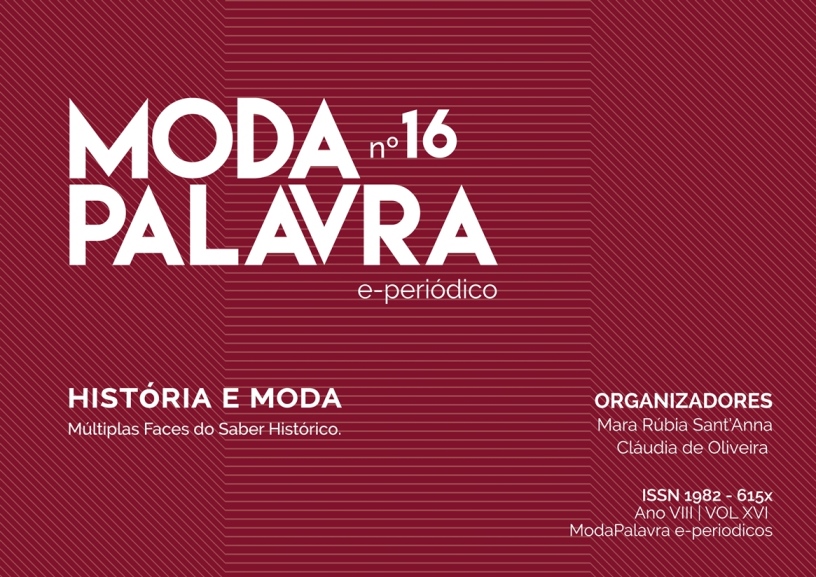A look at the role of the lacemaker woman in the Brazilian fashion history
DOI:
https://doi.org/10.5965/1982615x08162015050Keywords:
fashion history, lace maker woman, brazilian societyAbstract
This article aims to study the role of the lacemaker woman in the Brazilian society, discussing the changes, the gain of knowledge and the reinterpretation of lace made by hand in the twentieth and twenty-first century. For this, it ́s based on the analysis of social and cultural aspects as well as the approach the micro-history life of the elite lady of Rio de Janeiro, lace maker, consumer and collector. Analyzing the two main social settings, the elite and the working class, it was found that lace production relation, in all the centuries studied, have changed due to the current model of women's live.
Downloads
References
ANDRADE, Rita. Por debaixo dos Panos: cultura e materialidade de nossas roupas e tecidos. In: Tecidos e sua conservação no Brasil: museus e coleções. São Paulo: Museu Paulista da USP, 2006.
BALBINOT, G.; PEREIRA, R.; ZANELLA, A. A renda que enreda: analisando processos de constituir-se rendeira. Educação&Sociedade, Vol. 21, n. 71. Campinas, jul., 2000. Disponível em http://www.scielo.br/scielo.php?script=sci_arttext&pid=S0101-73302000000200011. Acesso em 18 fev. 2015.
BARROS, J. de A. Sobre a feitura da micro-história.OPSIS, vol. 7, nº 9, jul-dez 2007. Disponível em www.revistas.ufg.br/index.php/Opsis/article/download/9336/6428. Acesso em20 abr. 2015.
______; História da Cultura Material: notas sobre um campo histórico em suas relações intradisciplinares e interdisciplinares. In: Patrimoniuss,março/2009. Disponível em http://campodahistoria.blogspot.com.br/2011/01/historia-da-cultura-material.html. Acesso em 28 mai.2015.
BERGAMIN, C. A importânciada renda de bilro na economia familiar em Florianópolis a partir de 1900 e a sua continuidade no tempo presente. Revista Santa Catarina em História-Florianópolis, v.7, n.1, 2013 . Disponível em www.nexos.ufsc.br/index.php/sceh/article/download/561/270. Acesso em20 abr. 2015.
BIASOLI-ALVES, Z. M. Continuidades e rupturas no papel da mulher brasileira no século XX. Psicologia: Teoria e Pesquisa. Set-Dez 2000, Vol. 16 n.3, PP. 233-239. Disponível em: http://www.scielo.br/pdf/ptp/v16n3/4810.pdf. Acesso em16 abr. 2015.
BORGES, A., 2011. Design+Artesanato: o caminho brasileiro. SãoPaulo: Editora Terceiro Nome.
FALCI, Miridan Knox. Mulheres do sertão nordestino. In: DEL PRIORE, Mary (org.) História das Mulheres no Brasil.São Paulo: Contexto, 2010, p. 241 -277.
GINZBURG, C. Sinais: raízes de um paradigma indiciário. In: Mitos,emblemas, sinais. São Paulo: Companhia das Letras, 1994. p.143-179.
OLIVEIRA, Márcia P. Coleção Luiza Ramos: um nordeste imaginado em rendas.Dissertação de Mestrado –Mestrado em Museologia e Patrimônio. Universidade Federal do Rio de Janeiro. Rio de Janeiro,2014.
PROWN, J. Mind in matter: an introduction to material culture theory and method. In: PEARCE, S. Interpretingobjects and collections. Londres: Routledge, 1994. p. 133-138. Disponível em http://blogs.ubc.ca/qualresearch/files/2010/09/Mind-in-Matter.pdf. Acesso em 25 abr. 2015.
RAGO, Margareth. Trabalho feminino e sexualidade. In: DEL PRIORE, Mary. História das Mulheres no Brasil. São Paulo: Contexto, 2010, p. 578 -606.
SOUZA, G. de M. O espírito das roupas: a moda no século dezenove.São Paulo, Companhia das Letras, 1987.
Downloads
Published
How to Cite
Issue
Section
License
Copyright (c) 2015 Vera Felippi, Evelise Anicet Rüthschilling, Joana Bosak de Figueiredo

This work is licensed under a Creative Commons Attribution-NonCommercial 4.0 International License.
When submitting an article for publication in ModaPalavra e-periodico, the author (s) agree (s) with the following terms:
- Authors maintain the copyright in their manuscripts and grant the journal the right of first publication, with work simultaneously licensed under the Creative Commons Attribution-NonCommercial 4.0 International, which allows sharing the work with the acknowledgment of authorship and the initial publication in the journal without payment ;
- Authors may use the same results in other publications after the first publication, provided that they indicate ModaPalavra e-journal as the original publication medium;
- Authors are authorized to take additional contracts, separately, only after the original publication in ModaPalavra e-journal, provided they indicate ModaPalavra e-journal as the original publication medium;
- Authors are allowed and encouraged to publish and distribute their work online (eg in institutional repositories or on their personal page), only after the editorial process and the first publication, provided they indicate ModaPalavra e-journal as the original publication medium;
- To indicate ModaPalavra e-journal as the original publication medium, authors should use the following text template: "This article was originally published by ModaPalavra e-periodical, under a CC BY NC license, in its volume [insert volume] number [insert number] in the year of [insert year], and can be accessed at: http://www.revistas.udesc.br/index.php/modapalavra/ ";
- The opinions expressed in the articles are the author’s sole responsibility, not necessarily reflecting the journal’s opinion. The publication of any material that is owned and held in copyright by a third party, including – but not limited to - articles, photos or drawings was previously authorized by their representatives to be published in ModaPalavra e-journal.










